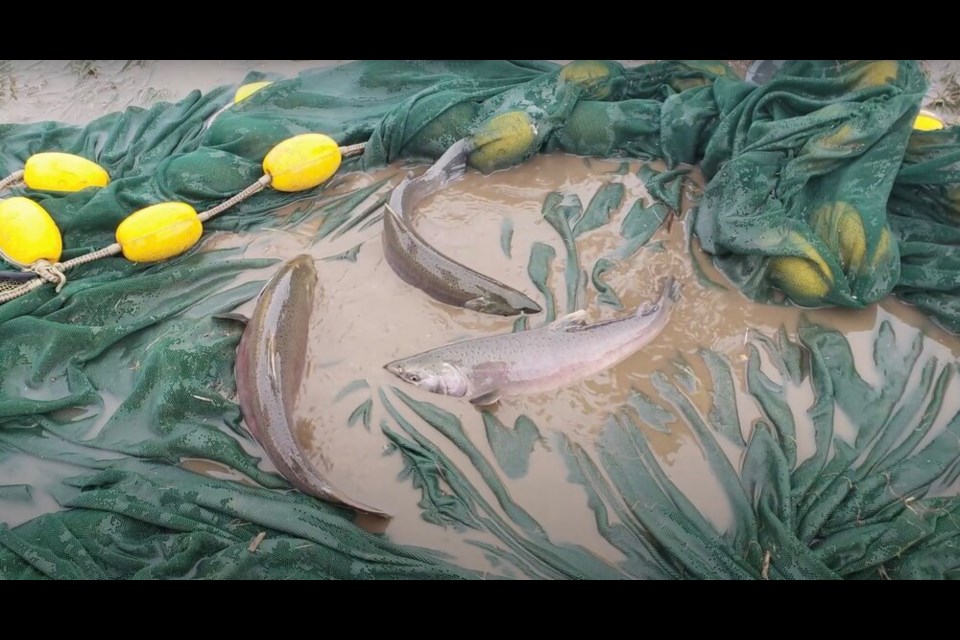First Nations and environmentalists have rescued dozens of endangered coho salmon over the past week after November’s devastating flooding left them stranded in fields of several Abbotsford farmers.
In one week, crews from the Sumas and Sto:lo nations, as well as staff from the Pacific Salmon Foundation rescued 26 coho salmon — many of them females that hold thousands of eggs vital to keep the endangered runs alive.
“We don’t know exactly where the fish came from. But when the floods happened the salmon came into these fields from breaches in the dikes,” says Jason Hwang, vice-president of the Pacific Salmon Foundation.
Escaping into quiet backwaters to ride out a flood is natural behaviour for salmon, but when natural flood plains are diked off and turned into farmland, the fish have a hard time making their way back to the river, says Hwang.
In the days after the flooding in mid-November, reports of stranded sturgeon circulated on social media, with one fishing guide taking it upon themselves to rescue several of the ancient fish.
“That was a signal there were fish flushed out into the fields,” said Hwang. “Once the water started to recede, we thought we’d have a look.”
Hwang’s group hired biologist Mike Pearson, an expert who has spent years researching fish on the Nooksack River. Crews were brought in from the Sumas Nation and Sto:lo Nation to round out the recovery team.
Several fields the group surveyed near Highway 1 and Whatcom Road sat abandoned, the farmers having been displaced; in other cases, the farmers had no problem with the group wading through the muddy, knee-high floodwaters.
Hwang says they expected to find a lot of juvenile salmon, but they were nowhere to be seen, the easy prey likely picked from newly formed pools by thousands of birds.
Then they started coming across what appeared to be healthy adult fish.
“It’s quite amazing that we did find adult coho and they were, at least to a biologist’s eye, in good shape,” Hwang tells Glacier Media. “The fish are fantastic.”
Or as one young volunteer put it, “I never thought I'd be in my field fishing for coho salmon.”
While 26 fish might not seem like a big number, the projected devastation of many salmon runs across flood-affected tributaries means any egg-bearing adult could be the difference between extirpation and survival.
From the muddy field water, all the adult coho were moved and released into the Sumas River.
Elsewhere in the province, it has been harder to gauge what kind of damage has been done to salmon populations and the habitat they live in. The expectation, says Hwang, is that in rivers like the Coldwater, Coquihalla and Nicola, researchers will find spawning salmon have been washed away.
“The effects are probably very, very serious,” he says.
In the days after the flooding, Simon Fraser University researcher Jeremy Venditti boarded a helicopter to survey the damage to fish habitat up the Fraser River and its tributaries. What he found was both reassuring and sobering.
On the one hand, he found no major changes to the morphology of the Fraser or Thompson rivers. Other, small watersheds were devastated.
“In the Coquihalla River, in places where there might have been salmon, the river has changed so much there that the eggs have been washed away — for sure,” says Venditti.
Just how many fish have been killed and how much habitat has been damaged won’t start to reveal itself until next spring, when researchers can survey juvenile fish populations in areas hit by flooding and landslides.
“You can’t get into the Nicola, the highway is gone,” says Hwang.
That picture will become even clearer when two years from now pink salmon start to return to the main branch of the Fraser; three years from now, researchers will be able to estimate how many surviving coho, chinook, chum and sockeye return to spawn the next generation.
Back in Abbotsford, staff from the Sumas Nation have taken over reconnaissance for any remaining salmon trapped in the floodwaters, and staff from Fisheries and Oceans Canada are on standby to help. Coho are well within their spawning season now, and likely have another week or two before their chance to drop eggs into the riverbed expires, says Hwang.
Clearly, their own survival is at stake too. As the waters continue to recede, any remaining fish face an increasingly hostile environment — less water means the concentration of pollutants climbs and temperatures are expected to plunge to minus 11 Celsius in the coming days, causing fields and ponds to freeze over.
“They won’t survive out there forever,” says Hwang. “The fish are on a clock.”




